Improvement Outcomes
Participants in Salud y Vida experience immediate progress in the control of diabetes such that the average Hba1c at baseline of 10.23% has dropped to 9.08% at 3 months.
There are fluctuations thereafter, with the average HbA1c of 9.24% at 6 months, and 9.3% at 9 months (see Figure 2). Enrollment in this program is ongoing, the results reported are based on the maximum # of people that have the reached that time point. This program is a rolling admission and every participant is at a different stage.

Despite slight increases in the overall average after 3 months, a large number of participants are reducing their HbA1c at each time point (see Figure 3). Data for those who have completed their HbA1c tests are shown in Figure 3. More than 60% are reducing their HbA1c at each time point.
The HbA1c decline over time differs for males and females after adjusting for the effect of baseline age (see Figure 4). It is shown that the HbA1c decreased by the end of the observed study period for both genders. However, HbA1c declined more quickly for males than females with rates of -0.32 vs -0.19 respectively.
Participants are registered into Diabetes Self-Management Education (DSME) classes in community-based settings that focus on educating and empowering participants to better manage their diabetes and improve their quality of life. These sessions focus on understanding the disease, addressing behavioral health issues, improving eating habits, maintaining adequate nutrition, increasing physical activity, understanding medication, developing self-management skills, improving the relationship between patient and healthcare provider, identifying support systems and utilizing community resources. To date, 35% of participants have completed all sessions (see Figure 5).

Figure 2: HbA1C Averages for each time point (every 3 months)
HbA1c is a measure of control of diabetes over the previous 3 month period. The higher the number the less control.
Lowering A1C levels reduces the risk of diabetes complications.
The results of the Diabetes Control and Complications Trial (DCCT) show that there is a 21% risk reduction per 1% decrease in A1C levels (p<0.0001).
Figure 3: Percent of individuals who have reduced or increased their HbA1c at each time point

Figure 4: Comparison of HbA1C between Males and Females

Participants are eligible to graduate from the program if their HbA1C result is reduced to below 9% by the 12-month or 15-month time point. Participants remain in the program if there is HbA1c is not yet below 9. Additional services to include medication therapy management and increase in contact will be offered to these participants. Please see participant testimonials below for two participants that have graduated from Salud y Vida.


